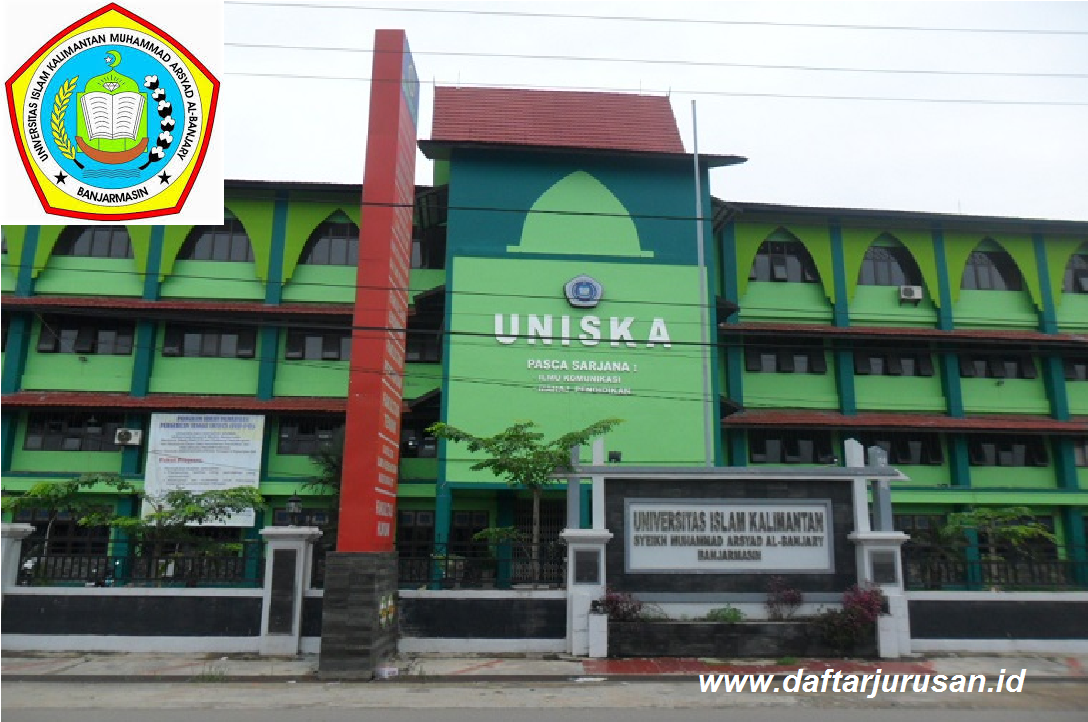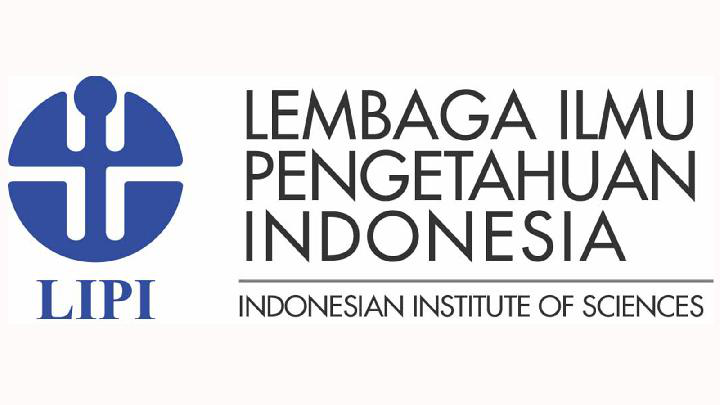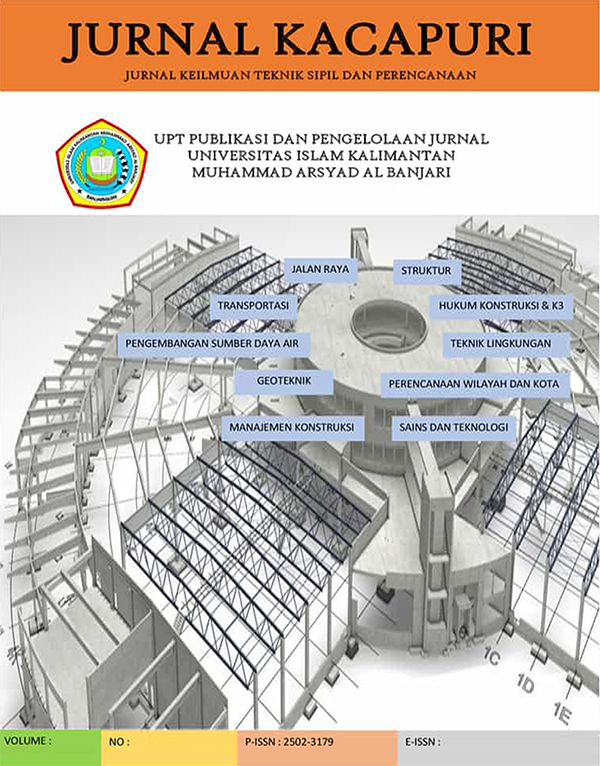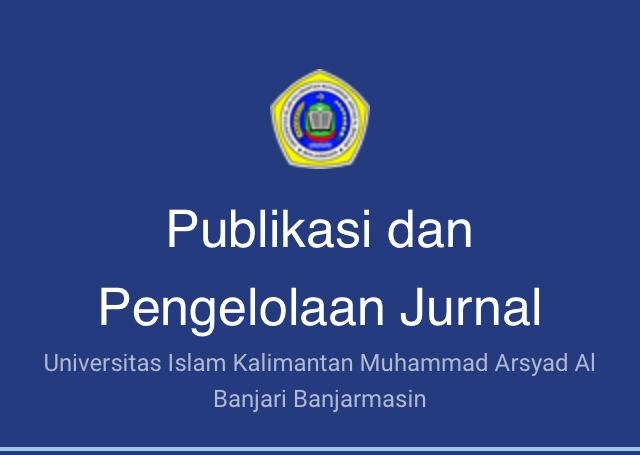PENGARUH ADANYA MATERIAL BERPORI TERHADAP KARAKTERISTIK KONSOLIDASI TANAH LEMPUNG LUNAK LAHAN BASAH
(1) Universitas Lambung Mangkurat Banjarbaru
(*) Corresponding Author
Sari
Salah satu cara untuk mempercepat aliran air maupun laju konsolidasi tanah lempung lunak lahan basah yaitu dengan menambahkan material porous didalam tanah maupun menggunakan drainasi vertical. Selama ini telah berkembang teknologi percepatan konsolidasi dengan vertical drain berbahan geosintetis. Selain berbahan geosintetis, bahan lainnya untuk material vertical drain masih terus dikembangkan untuk mencari keandalan yang ekonomis.Adapun yang menjadi permasalahan dalam penelitian ini adalah bagaimana derajat konsolidasi yang dihasilkan dari hasil pengujian konsolidasi tanah lempung lunak lahan basah yang ditambahkan adanya material berpori (berbahan pasir, sekam padi, dan arang kayu). Selain itu juga bagaimana pengaruh drainase (material berpori) radial, n (perbandingan diameter benda uji dan diameter drainase (material berpori)dari masing-masing material berpori.Dalam penelitian ini dilakukan uji konsolidasi dengan benda uji menggunakan tanah lempung lunak lahan basah. Pada bagian tengah benda uji diberi lubang berdiameter 0,75cm, 1cm, dan 1,5cm, kemudian ditambahkan material berpori berbahan pengisi berupa pasir, sekam padi, dan arang. Dari ketiga material berpori tersebut, selanjutnya akan dibandingkan sesamanya terkait kinerja material berpori sebagai sistem drainase (material berpori) didalam tanah. Hasil penelitian menunjukkan bahwa material sekam padi, pasir, dan arang dapat digunakan sebagai bahan drainase (material berpori) untuk tanah yang berkonsolidasi karena mampu meningkatkan nilai derajat konsolidasi (U%).Apabila ditinjau pada satu satuan waktu maka untuk jenis material drainase (material berpori)) berbahan sekam dapat menghasilkan derajat konsolidasi yang lebih besar dibandingkan material drainase (material berpori) berbahan pasir maupun arang.Material drainase (material berpori) berbahan sekam dapat menghasilkan nilai koefisien konsolidasi (Cv), nilai koefisien permeabilitas (k), dan nilai koefisien perubahan volume (mv) yang lebih besar dibandingkan dengan material drainase (material berpori) berbahan pasir dan arang.Nilai koefisien konsolidasi (Cv) semakin meningkat seiring dengan peningkatan nilai rasio diameter (n) hingga mencapai rasio diameter yang optimum (nopt), selanjutnya sesudah nilai rasio diameter optimum tercapai maka koefisien konsolidasi akan mengalami penurunan. Rasio diameter optimum pada tanah lempung lunak yang berkonsolidasi didapat pada nilai 6(enam).
Kata kunci : Konsolidasi tanah, drainase (material berpori) vertical,derajat konsolidasi,koefisien permeabilitas, koefisien konsolidasi dan tanah lempung lunak lahan basah.
One way to accelerate water flow and the rate of consolidation of wetland soft clay soil is by adding porous material in the soil and using vertical drainage. So far there has been a development of consolidation acceleration technology with a vertical drain made from geosynthetics. Apart from geosynthetics, other materials for vertical drain material are still being developed to find economical reliability. The problem in this research is how the degree of consolidation resulting from the consolidation test of wetland soft clay soil is added by the presence of porous material (made from sand, rice husk, and wood charcoal). In addition, also the effect of radial drainage (porous material), n (comparison of the diameter of the specimen and drainage diameter (porous material) of each porous material. In this study a consolidation test was carried out with specimens using soft soil wetlands. the center of the specimen was given a hole with a diameter of 0.75cm, 1cm, and 1.5cm, then added porous material made from fillers in the form of sand, rice husk, and charcoal. porous material) in the soil The results showed that rice husk, sand and charcoal material can be used as drainage material (porous material) for the soil that consolidates because it can increase the value of the consolidation degree (U%). for the type of drainage material (porous material) made from chaff can produce console degrees idasi which is bigger than drainage material (porous material) made from sand or charcoal. Drainage material (porous material) made from chaff can produce consolidated coefficient values (Cv), permeability coefficient value (k), and volume change coefficient value (mv) which is greater than the drainage material (porous material) made from sand and charcoal. The value of the consolidation coefficient (Cv) increases along with the increase in the diameter ratio (n) until it reaches the optimum diameter ratio (nopt), then after the optimum diameter ratio value is reached, the coefficient of consolidation will decrease. The optimum diameter ratio in soft clay that consolidates is obtained at a value of 6 (six).
Keywords: Soil consolidation, vertical drainage (porous material), degree of consolidation, permeability coefficient, consolidation coefficient, and wetland soft clay soil.
Teks Lengkap:
PDFReferensi
Abadi (2004), Uji Laboratorium Pemamfaatan Serabut Kelapa dan Ijuk sebagai bahan Drainase (material berpori) Vertikal tanpa Filter, Media Teknik, No.1 Tahun XXVI, Edisi Februari 2004, ISSN 0216-3012
Das B.M (1998), Principles of Geotechnical Engineering, PWS. Publishing Company, Boston, Massachusetts.
Eberemu (2011), Consolidation Properties of Compacted Lateritic Soil Treated With Rice Husk Ash, Geomaterials, 1, 70-78. doi:10.4236/9m2011.13011,Published online October 2011, http://www.scirp.org/journal/gm.
G Sumiyati (2015), Percepatan Penurunan Tanah dengan Metode Elektrokinetik, Bahan Ijuk, dan Sampah Plastik Sebagai Drainase (material berpori) Vertikal, Prosiding Konferensi Nasional Teknik SIpil 9 (KoNTeks9), Komda VI BMPTTSSI, Makassar, 7-8 Oktober 2015.
Indraratna, et al (2003), Modelling of Preabricated Vertical Drains in Soft Clay and Evaluation of Their Effectiveness in Practice, Journal of Ground Improvement, 7(3), 2003, PP 127-138, University of Wollongong Research Online.
Indraratna (2005), Radial Consolidation of Clay Using Compressibility Indice and Varying Horizontal Permeability, Canadian Geotechnical Journal, 42, 2005, PP 1330-1341
Mofiz (1989), Effect of Drains on Shear Strength and Consolidation Behaviour of Clay, Thesis, University of Engineering and Tech nology, Dhaka, Bangladesh.
Robinson and Shilpa (2008), Equal Strain Consolidation of Clays Under Radial Drainage, Indian Geotechnical Journal, 38(2), 2008, PP.204-220
DOI: http://dx.doi.org/10.31602/jk.v1i2.1788
Refbacks
- Saat ini tidak ada refbacks.

This work is licensed under a Creative Commons Attribution 4.0 International License.
















